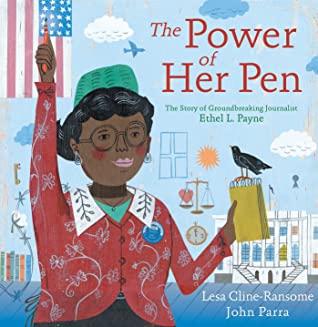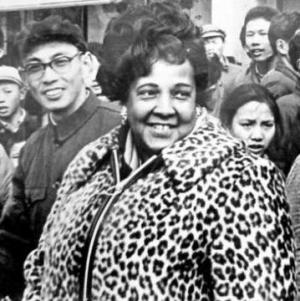Ethel Payne, known as “The First Lady of the Black Press,” was born on August 14, 1911 in Chicago. She became the first African American woman to be included in the White House Press Corps. She was known for asking questions that other journalists would not.
Lesa Cline-Ransome tells Ethel’s story in this picture book for older readers. She begins when Ethel was a young girl whose parents encouraged her to get a good education in spite of obstacles. She walked a mile each way to a white high school, and as the author reports:
“The neighborhood residents screamed and yelled and threw rocks at a black girl who dared to go to school with whites. ‘Sometimes I stood my ground, sometimes I got a bloody nose from fighting. But that was the way it was,’ Ethel later recalled.”
Payne graduated in the journalism program at Northwestern University, driven, as she told an interviewer in 1982, by a “great sense of indignation for people who couldn’t defend themselves.”
Wanting to see the world, in 1948, Payne took a newspaper job in Japan working for the Army Special Services Club. She wrote about the segregation of the soldiers and the racist treatment to which they were subjected, in spite of their having fought alongside white soldiers. She showed another reporter her diary, and he sent her notes to the “Chicago Defender,” the renowned African American newspaper. Her writing earned her a full-time position at the paper, and she began a career with the Defender in 1951.
After three years working for the Defender in Chicago, Payne moved to Washington, DC to cover national events for the paper, including the growing Civil Rights movement. She was one of only three black journalists issued a White House press pass.
Payne repeatedly asked President Eisenhower about his actions regarding discrimination and civil rights. Her pressing him on these issues, especially about the Supreme Court decision in 1954 to end “separate but equal” schooling, led to criticism of him in the press. Thereafter, President Eisenhower refused to call on her for the remainder of his presidency. His press secretary even tried to get her journalism credentials invalidated.
She carried on nevertheless, and after Eisenhower left office she continued to pose her probing questions to Presidents Kennedy, Johnson, Nixon, and Carter. Her articles brought more attention to the Civil Rights movement. She reported on Rosa Parks and the Montgomery Bus Boycott, and she interviewed Martin Luther King Jr. before he made national headlines. She also did extensive reporting on conditions for blacks in the South. As Cline-Ransome writes:
“It was her questions to presidents that finally made readers of all races pay attention to the plight of African Americans.”
In 1970, Payne broke another barrier and became the first African American woman to appear on a national network as a radio and television commentator. She worked for CBS from 1972-1982. In 1978, she left the Defender, and went on to serve as a professor for the School of Journalism at Fisk University in Nashville, Tennessee for one year. She also advocated for the release of Nelson Mandela.
Ethel Payne died of a heart attack May 28, 1991. She is remembered for her straightforward writing style, and her forceful questioning. Unfortunately, Payne’s legacy is not well known, and according to the Washington Post: “Had Ethel Payne not been black, she certainly would have been one of the most recognized journalists in American society.”
In 2002, Payne was one of four female journalists honored with a likeness on a U.S. postage stamp. The others were white journalists Ida Tarbell, Marguerite Higgins and Nellie Bly.
John Parra’s illustrations show a heavy influence of Mexican and American folk art, using color strategically to convey emotions and overall mood. Clearly he researched Payne’s life and times, shown by the images he has created.
The book ends with an Author’s Note, selected bibliography and suggestions for further reading.
Evaluation: This is yet another inspiring book spotlighting the courage and persistence of African Americans who overcame prejudice against their race, and in this case, gender as well, to make a difference for themselves and their country.
Rating: 4/5
A Paula Wiseman Book Published by Simon & Schuster Books for Young Readers, 2020













My daughter would love this book – thanks for the review!
I have fallen in love with picture books about important, often overlooked people. I love using them in our homeschool setting, as I often learn just as much as he does 🙂
Fascinating! What a remarkable woman!
It’s a great and wonderful book. I ought to know as I penned the first biography of Ethel Payne.